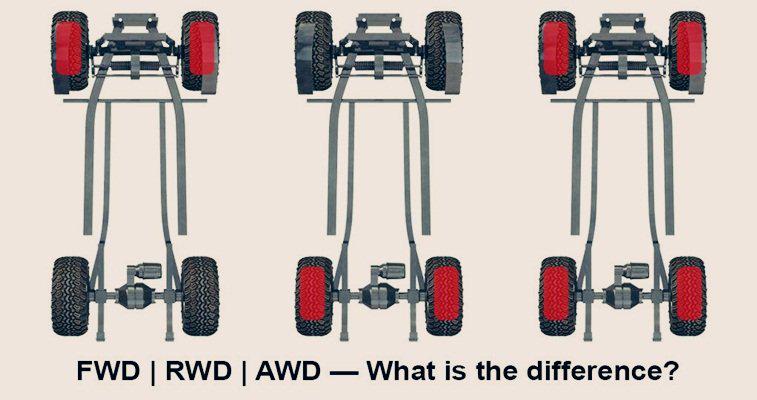Forgive us for engaging in maieutics right off the bat—doing as Greek philosopher Socrates did by answering a question with further questions—but that's how these things go. There is no single answer for everyone. Wisdom cannot be taught, only learned. So, if your pressing question has to do with vehicle drivelines and whether all-wheel drive (AWD), front-wheel drive (FWD), or rear-wheel drive (RWD) is best, we suggest you first look deep within and ask yourself a few more questions. First, are you simply seeking a transportation appliance that promises the greatest safety, economy, and practicality? Are you a driving enthusiast who finds joy in driving and is looking to form an emotional bond with their vehicle? How do you feel about off-roading, or acquiring and maintaining a second set of tires and possibly wheels for them to mount to?
We pose these not to be philosophical for philosophy's sake. Most people look at the choice between front-, rear-, and all-wheel drive through the lens of likely encounters with weather. Rear-wheel drive is seen as the enthusiast's choice, because driving the rear wheels leaves the front ones completely free to concentrate on steering, sending more of that wondrous "road feel" through to the steering wheel. All-wheel drive is gaining popularity alongside crossovers and SUVs as the "secure" choice for buyers who see rain and snow part or most of the year (or go off-road) and want the extra traction four-wheel drive affords, though we should remind you that it adds weight and doesn't help the vehicle steer or brake on slippery surfaces. Front-drive is the sensible-shoes choice, because with nearly every vehicle mounting its engine over the front wheels, that weight helps with traction when driving the front wheels, but front-heavy vehicles don't handle as nicely. Truth is, any drive system is workable in almost any weather, both because modern vehicles come with clever traction control systems and even cleverer buyers can go with the drive setup they want (say, rear-drive!) and simply purchase winter tires to deal with snow and such when the seasons change. So, the choice is yours, but let's start with some basics and discuss how these driveline choices line up.
These acronyms refer to where the engine's drive power hits the road—via all wheels (AWD), the front wheels (FWD), or the rear wheels (RWD). The world's first car was front-wheel drive. The 1769 Cugnot Le Fardier, a three-wheeled steam-powered contraption that could tow 5 tons at 2 mph, so long as it could get sufficient traction with its single driven steel-clad wooden front wheel. It lacked brakes and it was devilishly difficult to steer, what with the powertrain being rigidly attached to the single swiveling front wheel, so it's no surprise that most of the next attempts at automated mobility decoupled the driving and steering functions by employing rear-wheel drive. A British engineer named Bramah Joseph Diplock dreamed up all-wheel drive (plus four-wheel steering) in 1893 for a traction engine, and Ferdinand Porsche designed the first all-wheel-drive "car," the gas-electric hybrid Loehner Porsche in 1899. A semantics note on 4WD (four-wheel-drive) versus AWD—they essentially mean the same thing (at least for four-wheeled vehicles), but in modern parlance MotorTrend uses 4WD to denote the most off-road-focused systems that include low- and high-range gearing for precise climbing of rough terrain, while AWD describes full-time four-wheel drive systems that can be left on even when driving on high-traction surfaces such as pavement.
Engines generate rotational energy. The farther that energy must travel and the more times it must change directions before it turns the wheels, the less efficient the system is. So, the most efficient drivetrain theoretically is a transverse (perpendicular to the direction of travel) engine located right next to the axle it's powering. That means a front-engine FWD or rear-engine RWD setup is most efficient. Shafts connecting the engine to an axle at the opposite end of the car add inefficient mass and rotational inertia, and the bevel or worm-type gears required to redirect that rotational energy 90 degrees introduce further inefficiencies. AWD can never be as efficient as FWD or RWD with a traditional internal combustion engine. AWD systems that incorporate an electric motor at either axle, like in the electric Tesla Model Y, or plug-in hybrid Toyota RAV4 Prime notable exceptions.
Here again, a transverse engine snuggled right up against the driven axle is most space efficient. Sir Alec Issigonis proved this point with the original (front-engine/FWD) Mini, and cars like today's Smart ForTwo and Renault Twingo offer the counterpoint for a rear-engine/RWD layout. With no shafts, transmissions, or other bits intruding on the cabin, the floors of such vehicles can be flat and most of the vehicle's length can be devoted to carrying people and stuff.
A vehicle's potential accelerative traction can be computed by multiplying the total coefficient of friction between the driven tire(s) and the road surface by the instantaneous mass pressing down on these driven tires. Obviously, the only way to make 100 percent of the vehicle's weight work for this equation is to drive all four wheels, so AWD holds an inherent advantage in accelerative traction (note that for braking, it mostly just adds unhelpful mass and inertia—something to keep in mind when you see even 4WD or AWD vehicles in the ditch after a snowstorm).
Cantilevering the engine off the front of a FWD axle or the back of a RWD axle is like putting a big kid on a teeter-totter—it adds weight to the driven axle and subtracts it from the undriven one. This is good for traction when setting off in a straight line. It's less good for dynamic handling, where that weight imbalance can lead to under- or oversteer when turning aggressively in low traction situations. We should also remember that most of a vehicle's weight is positioned higher than the axles, so when we accelerate forward, the center of mass shifts backward, momentarily adding to the load on the rear axle. For this reason, locating the engine near or at the back of the vehicle further improves the traction available to a RWD vehicle.
Note: Here's where our earlier tire question comes into play. Because a proper winter tire can more than double the coefficient of cold-weather friction relative to a standard all-season tire, a FWD or mid- or rear-engine RWD vehicle with winter tires might easily out-accelerate an AWD vehicle on all-season tires in snow or on slick surfaces. Naturally, combining AWD and winter tires is the ultimate traction solution. But remember that when braking or turning, AWD hardware mostly just adds mass, so the ultimate winter safety of a FWD vehicle on winter tires could easily eclipse that of an AWD car. If you can swing the cost of an extra set of tires and live somewhere that sees significant winter weather, we strongly recommend considering winter rubber.

Frankly the driven axle(s) have little to do with passive safety, although in slippery conditions, breaking traction under power with FWD tends to lead to understeer while breaking traction with RWD can cause oversteer. Of these options, understeer is generally considered "safer" or at least more benign, given how you'd slide forward in the direction of travel, not sideways or possibly backwards as with oversteer. An AWD system could break traction at either axle, depending on its design.
Locating the engine up in the crumple zone ahead of the passengers can offer some added protection, but savvy engineering and materials science make modern mid- and rear-engine cars just as crashworthy as front-engine ones. As for enhancing the driver's ability to actively avoid an accident by driving out of a dangerous situation, a neutral weight balance and a low polar moment of inertia are important, so an argument could be made that a mid-engine RWD or AWD vehicle pencils out as "safest."
We can recommend wonderful driving cars with each of the above drivetrains, but the engineering and driving-fun decks are stacked against FWD. Blame the "friction circle." Because every tire only has so much friction force to apportion (coefficient of friction times mass), every bit of longitudinal acceleration force it generates comes at the expense of force that can be applied laterally for turning. That means that powering out of a turn is far less satisfying in a FWD vehicle. The same decks are therefore inherently stacked in favor of RWD and AWD vehicles that bias more torque to the rear. Of course, as total engine power and torque rises to a point that threatens to overwhelm two tires, AWD becomes necessary to safely or more cleanly put power down when exiting turns.
As noted above, only AWD vehicles can take full advantage of every ounce of onboard mass in generating accelerative friction. But remember that mass, friction, and rotational inertia are all inherent enemies of acceleration, and AWD systems add a lot of each. So just as in the winter traction example above, it's highly likely that—at least for vehicles with less than 400-500 horsepower, fitting a set of drag slicks or dry traction-optimized summer tires to a RWD vehicle might allow it to easily out-drag a similar AWD vehicle on all-season tires.
Pros: Extremely efficient in terms of cost, mass, space, and fuel consumption with engine located near drive wheels and no excess rotational inertia or friction from driveshafts; locating powertrain weight over the drive wheels is good for traction; safer understeer is more likely in power-on traction-loss scenarios; locating engine mass in front of the passenger compartment might improve crash safety.
Cons: Tires tasked with acceleration have less friction available for turning and can wear out more quickly; heavy front weight bias compromises handling responsiveness.
Pros: Allowing the front tires to specialize in steering while the rear tires do the driving vastly improves both steering feel and ultimate cornering grip; (mid- or rear-engine): engine weight over drive wheels plus dynamic rearward weight shift during acceleration optimizes accelerative traction.
Cons (Front engine): Reduced foul-weather traction compared to FWD and AWD on equal tires and propensity toward oversteer; added mass, cost, friction, rotational inertia of driveshaft, and gearing.
Pros: Inherent traction advantage in all conditions, especially accelerating through turns and as engine power approaches or exceeds a level that can overwhelm two driven tires.
Cons: Added cost, weight, rotational inertia, and friction reduce efficiency in all driving situations.




